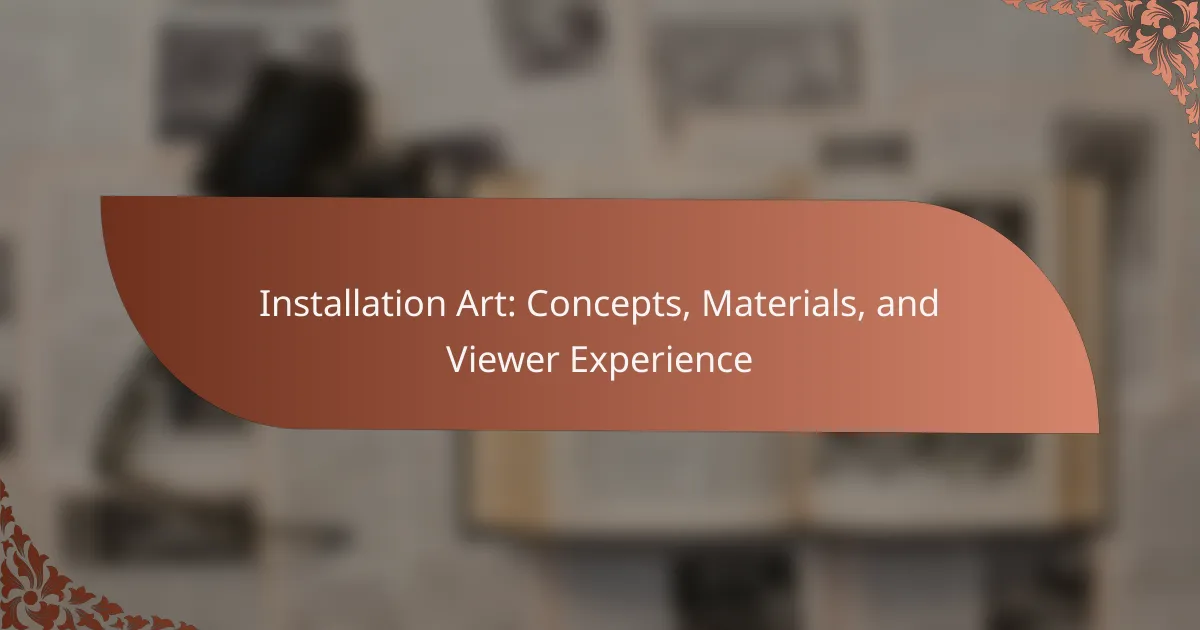Installation art captivates audiences by creating immersive environments that provoke thought and engagement. This article explores key concepts like site specificity and interactivity, examines diverse materials used, and discusses how cultural context shapes viewer experiences. Additionally, it highlights the unique attributes of notable installation artists and the challenges they face in their creative process. Finally, it emphasizes the importance of emotional engagement and accessibility in enhancing the impact of installation art.
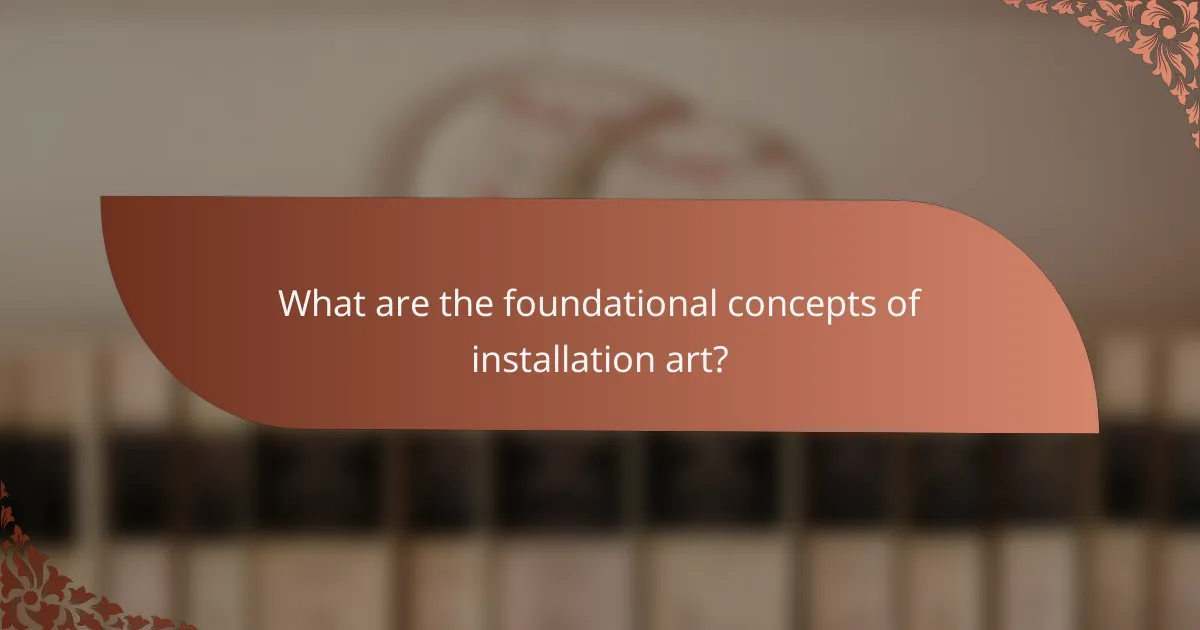
What are the foundational concepts of installation art?
Installation art integrates various concepts, materials, and viewer experiences to create immersive environments. Key foundational concepts include site specificity, interactivity, and the use of everyday materials. Site specificity emphasizes the relationship between the artwork and its location, while interactivity invites viewer participation, enhancing engagement. The choice of materials often reflects cultural or social themes, adding depth to the experience. These elements work together to transform spaces and provoke thought, making installation art a unique form of contemporary expression.
How do spatial relationships influence viewer engagement?
Spatial relationships significantly enhance viewer engagement by creating a dynamic interplay between the artwork and its environment. These relationships influence perception, guiding how viewers navigate and interact with the installation. For instance, proximity to other objects can evoke emotional responses, while the arrangement of space can alter the viewer’s focus. Effective spatial design invites exploration, encouraging deeper contemplation and connection with the artwork. This interaction can transform a passive viewing experience into an active engagement, making the installation more memorable and impactful.
Why is interactivity a key aspect of installation art?
Interactivity is essential in installation art because it enhances viewer engagement and transforms passive observation into active participation. This dynamic relationship allows viewers to influence the artwork, creating a unique experience. As a result, interactivity fosters deeper emotional connections and encourages personal interpretation. Furthermore, it often incorporates technology, expanding the boundaries of traditional art forms.
Which themes are commonly explored in installation art?
Installation art commonly explores themes of space, perception, identity, and social commentary. These themes invite viewers to engage with their surroundings and reflect on personal and collective experiences. For example, the use of unconventional materials often challenges traditional notions of art, prompting discussions about value and context. Additionally, installation art frequently addresses environmental concerns, urging audiences to consider their impact on the world.

What materials are typically used in installation art?
Installation art typically uses a diverse range of materials including found objects, natural elements, textiles, and digital media. These materials create immersive experiences that engage viewers. Commonly, artists incorporate light, sound, and video to enhance interactivity. Unique attributes of installation art often involve site-specific elements tailored to the exhibition space.
How do different materials affect the viewer’s experience?
Different materials significantly shape the viewer’s experience in installation art. The texture, color, and form of materials influence emotional responses and interpretations. For example, soft fabrics may evoke comfort, while hard metals can create feelings of rigidity or industrialism. Additionally, interactive materials encourage engagement, fostering a deeper connection with the artwork. The choice of biodegradable versus synthetic materials can also impact perceptions of sustainability and environmental consciousness. Overall, the material selection is crucial in creating immersive and thought-provoking experiences for viewers.
Which unconventional materials are emerging in contemporary installations?
Unconventional materials in contemporary installations include recycled plastics, organic matter, digital media, and found objects. These materials challenge traditional art forms and engage viewers in new ways. For example, artists use biodegradable materials to create installations that evolve over time, emphasizing environmental themes. Additionally, incorporating technology, such as augmented reality, transforms viewer interaction, making the experience more immersive and dynamic. This approach not only broadens the definition of installation art but also invites critical dialogue about sustainability and innovation in artistic practices.
Why is sustainability becoming important in material selection?
Sustainability is crucial in material selection because it minimizes environmental impact and promotes resource efficiency. Artists increasingly prioritize eco-friendly materials to reduce waste and enhance viewer engagement. Sustainable practices foster innovation and encourage the use of renewable resources, aligning with contemporary values of responsibility and stewardship. As a result, installation art evolves to reflect societal concerns about climate change and ecological preservation.
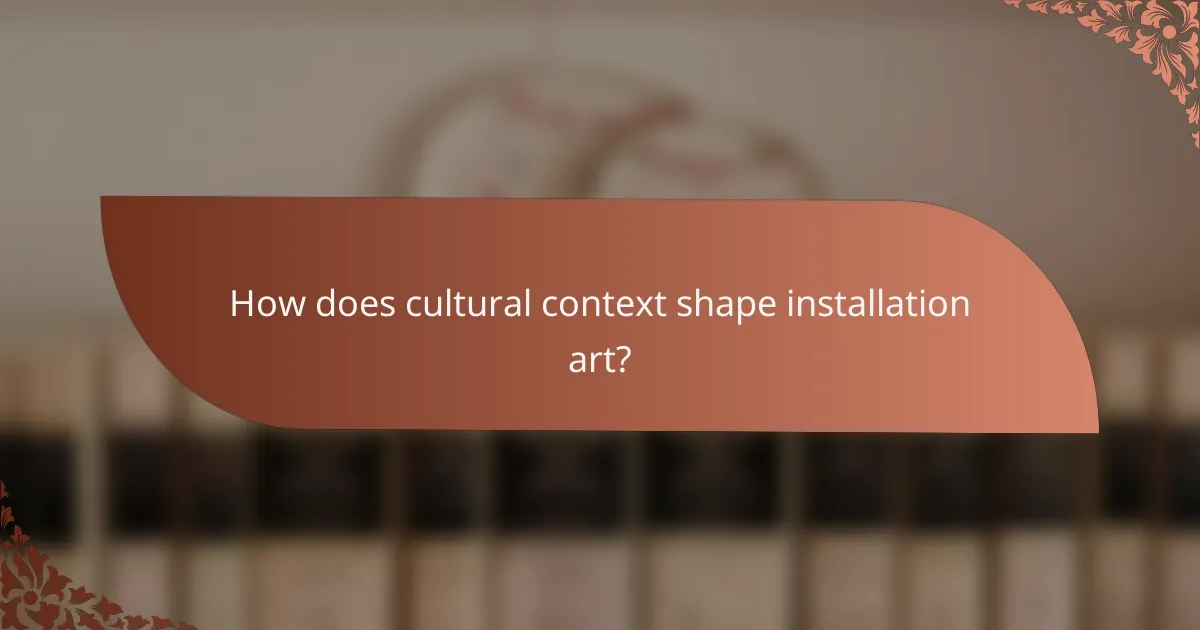
How does cultural context shape installation art?
Cultural context significantly influences installation art by shaping its themes, materials, and viewer interactions. Artists often draw from local traditions, historical narratives, and societal issues, creating works that resonate deeply within their cultural frameworks.
For example, installation art in urban settings may incorporate elements of architecture and community identity, while rural installations might reflect natural landscapes and local folklore. This contextual relevance enhances viewer engagement, prompting personal reflections and communal dialogues.
Moreover, cultural context can determine the materials used in installation art. Artists may choose locally sourced or culturally significant materials, which adds layers of meaning. This unique approach not only honors traditions but also challenges contemporary perceptions of art and space.
Ultimately, installation art serves as a mirror to its cultural surroundings, inviting audiences to explore their identities and histories through immersive experiences.
What role do local traditions play in the creation of installations?
Local traditions significantly influence the creation of installations by providing cultural context and thematic depth. Artists often draw inspiration from regional customs, rituals, and historical narratives, enriching their work’s meaning. This connection can enhance viewer engagement, as local audiences may resonate with familiar elements. Moreover, unique attributes of specific traditions can lead to rare artistic expressions, making installations distinct and reflective of their cultural origins. By integrating local traditions, artists not only honor their heritage but also invite broader discussions on identity and community through their installations.
How do global trends influence regional installation practices?
Global trends significantly shape regional installation practices by influencing artistic themes, material choices, and viewer engagement. Artists often draw inspiration from global movements, leading to unique local adaptations. For instance, sustainability trends encourage the use of eco-friendly materials in installations, reflecting a growing awareness of environmental issues. Additionally, advancements in technology facilitate innovative installation techniques, allowing artists to create immersive experiences that resonate with contemporary audiences. As a result, regional practices evolve, integrating global influences while maintaining local cultural identities.

What are the unique attributes of notable installation artists?
Notable installation artists possess unique attributes that distinguish their work. These include immersive environments that engage multiple senses, innovative use of space that transforms perceptions, and interactive elements that invite viewer participation. Additionally, they often incorporate unconventional materials that challenge traditional art forms, creating a dialogue between the artwork and its context. Their ability to evoke emotional responses through thematic depth further sets them apart in the art world.
Which artists have redefined the boundaries of installation art?
Artists who have redefined installation art include Yayoi Kusama, Olafur Eliasson, and Damien Hirst. Yayoi Kusama’s immersive environments challenge perceptions of space and infinity. Olafur Eliasson’s installations often incorporate natural elements, engaging viewers with their surroundings. Damien Hirst’s works provoke thought on life and death through provocative installations. These artists push boundaries, transforming viewer experiences and expanding the definition of installation art.
How do personal narratives influence the work of installation artists?
Personal narratives significantly shape installation artists’ work by infusing personal experiences and perspectives into their creations. These narratives provide context, deepening viewer engagement and emotional resonance. Artists often draw on their histories to create immersive environments that invite reflection. For instance, an artist may use materials symbolizing their cultural background, enhancing the installation’s meaning. This unique attribute fosters a connection between the artwork and the audience, allowing for diverse interpretations. As a result, personal narratives become a vital component in the conceptual framework of installation art, influencing both the creative process and viewer experience.

What challenges do installation artists face in exhibition spaces?
Installation artists face challenges such as spatial limitations, audience engagement, and material durability. These factors influence the overall impact of their work.
Spatial limitations can restrict the size and scope of installations, forcing artists to adapt their concepts. Audience engagement varies, as not all viewers interact with installations in the same way, affecting the intended experience. Material durability is crucial; installations often use fragile components that may not withstand the exhibition environment.
Additionally, logistical issues like transportation and setup can complicate the installation process. Artists must also navigate institutional expectations, which may impose constraints on creativity.
How do logistical constraints impact installation design?
Logistical constraints significantly influence installation design by limiting space, materials, and accessibility. These factors determine how artists conceptualize and execute their work. For instance, spatial limitations can dictate the scale and form of the installation. Material availability affects not only the aesthetic but also the structural integrity of the piece. Accessibility considerations ensure that the viewer can engage with the installation, impacting its overall experience. Thus, logistical constraints shape both the practical and artistic dimensions of installation art.
What are common misconceptions about installation art?
Common misconceptions about installation art include the belief that it is solely about aesthetics or that it lacks meaning. Many assume installation art requires expensive materials, while others think it can only be experienced in galleries. Additionally, some people believe installation art is temporary and lacks permanence. These misconceptions overlook the depth of viewer interaction and the diverse materials used, which can range from everyday objects to high-tech installations. Understanding these nuances enriches the appreciation of installation art as a multifaceted experience.
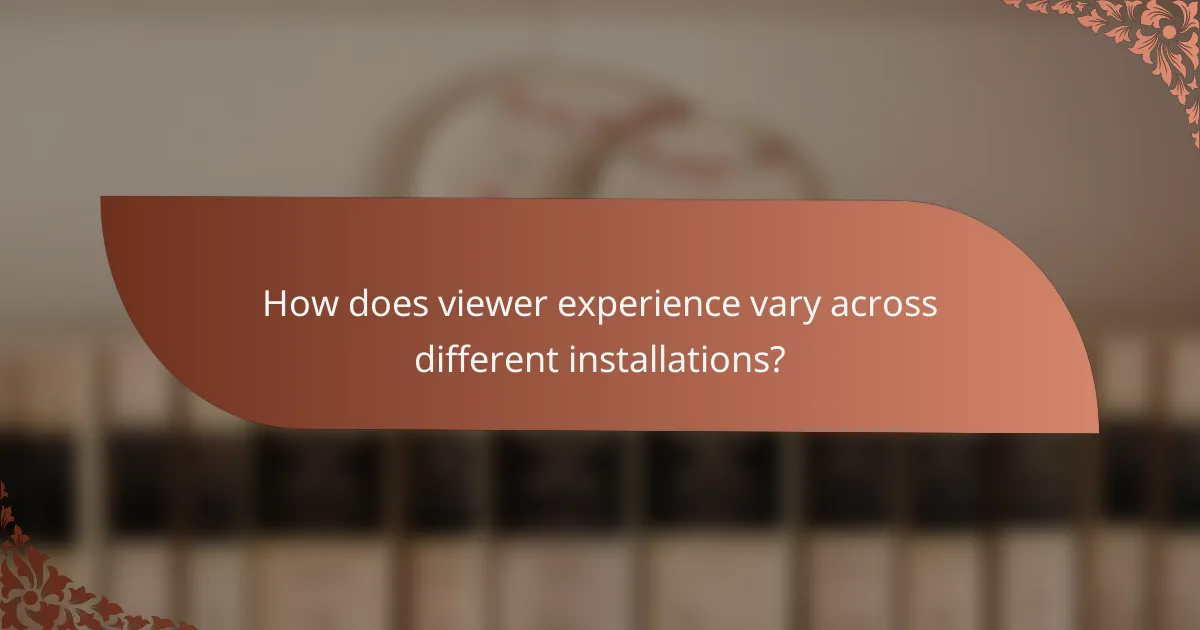
How does viewer experience vary across different installations?
Viewer experience varies significantly across different installations due to factors like spatial design, materials used, and interactivity levels. Unique attributes of each installation can enhance or diminish viewer engagement. For example, immersive installations often create a sense of presence, while minimalist designs may evoke introspection. The emotional response can differ based on the installation’s context and the viewer’s personal interpretation. As a result, installations that encourage interaction tend to foster deeper connections compared to static displays.
What psychological effects do immersive installations have on audiences?
Immersive installations significantly influence audiences by evoking emotional responses and enhancing engagement. These experiences can foster a sense of presence, leading to deeper connections with the artwork.
The psychological effects include increased empathy and introspection, as viewers often reflect on personal experiences in relation to the themes presented. For example, installations that utilize sensory elements can create feelings of nostalgia or discomfort, shaping viewer perceptions.
Moreover, immersive art can alter cognitive processing, allowing for new perspectives on familiar concepts. This transformation can stimulate creativity and inspire action, making the viewer’s experience both memorable and impactful.
Overall, immersive installations serve as powerful tools for emotional and psychological exploration, transforming passive observation into active participation.
How do installation art exhibitions differ from traditional art displays?
Installation art exhibitions engage viewers through immersive experiences, unlike traditional art displays that focus on static pieces. Installation art often transforms the entire space, encouraging interaction and emotional responses. Traditional displays typically emphasize individual artworks in a more formal setting. The use of diverse materials in installation art, such as sound, light, and movement, creates a unique sensory environment that challenges conventional viewing. In contrast, traditional art often relies on established mediums like painting or sculpture, maintaining a clear separation between art and audience.
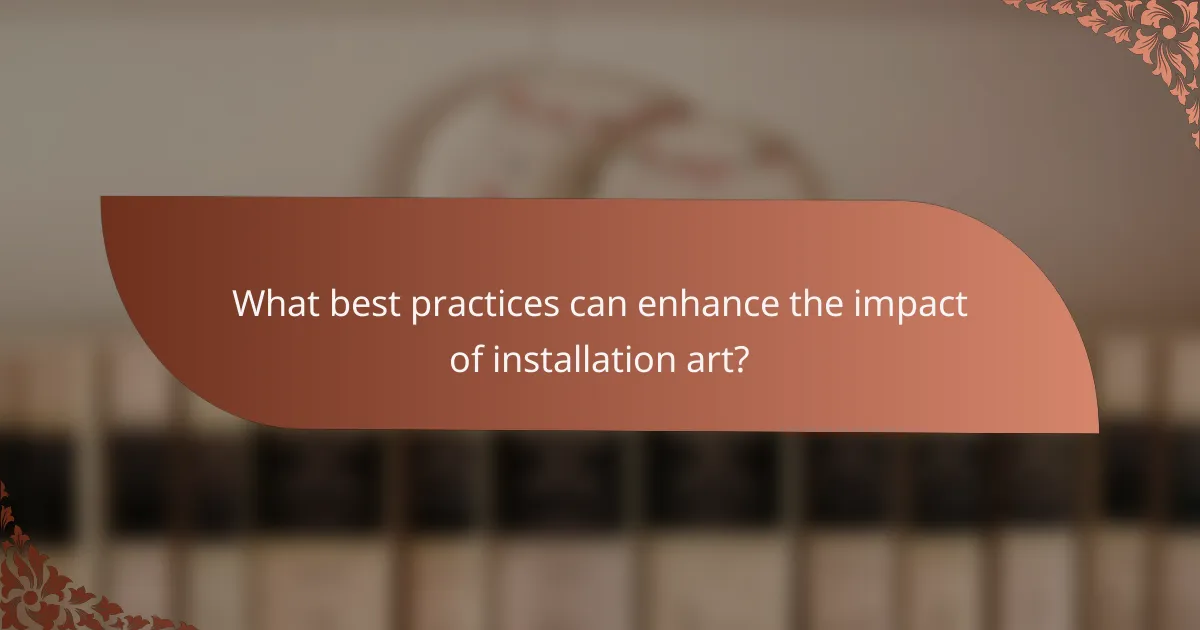
What best practices can enhance the impact of installation art?
To enhance the impact of installation art, focus on interactivity, context, and emotional engagement. Incorporating viewer participation creates a dynamic experience, while situating the artwork within its environment strengthens its relevance. Additionally, evoking emotions through sensory elements can deepen connections with the audience.
Utilizing diverse materials and innovative techniques can also elevate the artwork’s presence. Collaborating with other artists or disciplines introduces unique perspectives, enriching the overall experience. Finally, promoting accessibility ensures a wider audience can engage with the installation, enhancing its impact.
Which strategies can artists use to engage audiences effectively?
Artists can engage audiences effectively by creating immersive experiences, utilizing interactive elements, and fostering emotional connections. Installation art thrives on audience participation, making the viewer an integral part of the artwork.
Incorporating sensory elements enhances engagement. For example, using sound, light, and texture can evoke emotions and encourage exploration. Collaborations with other disciplines, such as technology or performance art, can also attract diverse audiences.
Implementing social media strategies allows artists to extend their reach and engage with audiences beyond the physical space. Encouraging audience feedback and interaction through digital platforms fosters a sense of community.
Lastly, tailoring experiences to specific audiences increases relevance. Understanding the demographics and interests of viewers can guide the creation of art that resonates deeply, ensuring a lasting impact.
What common mistakes should artists avoid in installation art?
Artists should avoid common mistakes such as neglecting the viewer’s experience, overcomplicating concepts, using inappropriate materials, and failing to consider the installation’s context. These errors can diminish the impact of installation art.
Neglecting the viewer’s experience can lead to installations that fail to engage. Overcomplicating concepts may confuse rather than inspire. Using inappropriate materials can undermine the intended message. Finally, ignoring the installation’s context can result in disconnection from the audience.
